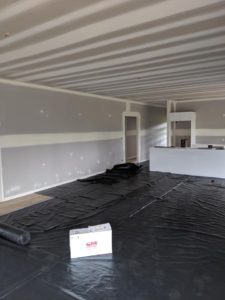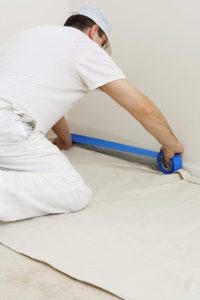If you’re wondering, how to spray paint interior walls and ceilings, you’ve come to the right place. After all, freshly painted walls is one of the best ways to spruce up your place and breathe new life into it.
As a DIYer, painting can be an exciting chance to roll up your sleeves and beautify your house. In general, this is when you get a lot of decoration ideas as you think about the right color and theme for your walls.
Nevertheless, the joys of handling your interior painting project come with the mandate of mastering ways to handle this job efficiently. If you are an amateur looking forward to handling such an essential task without assistance, it is vital to try out smaller projects first. This will be an opportunity to try out your spray painting skills before going for those interior walls.
The good news is that DIY painting jobs have become more manageable, as long gone are the days when such projects were more demanding. This is because you no longer have to be limited to using paintbrushes and rollers, since spray-painting has become the new norm.
How to Spray Paint Interior Walls and Ceilings – First Steps

The key to effective paintwork is preparation. This is often the difference between expert work and poorly done amateur work. A rule of thumb is to first invest in the right tools for the job as this is the only way to avoid last-minute inconveniences. To make your work easier, you will need:
- Personal protection equipment that includes; goggles, respirator, long-sleeved suit, and gloves.
- Hand Tools such as sandpaper, scrapers, and filling blades.
- Quality spray-painting equipment.
- Other equipment like drop cloths, clean dusters, putty, and masking tape.

How to Prepare Walls before Painting
It is essential to prepare your walls before any painting project to achieve an excellent finish. This is because you are guaranteed to find greasy substances, cracks, holes, or stuck wallpaper on your walls. To ensure that all these situations are under control, you will need to:
- Dust your walls and let them dry completely. You will need a clean duster for this step that is meant to get rid of dust and dirt on your walls. After cleaning the walls, give it time to dry and become moist-free. This is why it is advisable to wait for dry weather before handling that interior painting project.
- Ensure that the entire wall surface is smooth. If you discover holes, cracks, stuck wallpaper, or crusty plaster, you need to have them cleared. To fix holes and crack, you will need to fill them using putty after cleaning them using sugar soap. Sugar soap solution can also be used to remove greasy substances and stuck wallpaper from walls.
- If the entire wall was initially covered with wallpaper that has become hard to remove, pour hot water on them. This will soften the wallpaper that can then be easily removed using a stripping knife.
- Once your wall is free from all unwanted items, you should sand them slightly. This is critical if you want to have a smooth texture that will be easier to paint.
- If you are planning on painting a room that has been in use, ensure that you remove all furniture.
- Finally, it would be best to cover the floor with drop cloths and mask surfaces such as electrical fittings, windows, and doors. This is easily completed using masking tape that protects these surfaces from paint drips and runs.
How to Spray Paint Interior Walls and Ceilings – Step by Step Instructions
Once you have followed the steps mentioned above on how to prepare your wall before painting, now it is time to do the actual job. The step by step instructions to follow are:
1. Prepare your spray paint.
While spray painting gives you an edge over using brushes and rollers, there is a difference in how you handle each technique. You need to maintain a lighter paint density when spray-painting compared to when using a brush or roller for painting. This is because of the ever-present risk of over-spraying that needs to be regulated.
The secret to ensuring consistency in your paint’s density is to follow the instructions on the paint-box. You should also try and mix the paint that will be used at a go to avoid the risks of the varying density of paint. Overly, most of the paint needs to dilute in water or thinner for a runny or thinner consistency.
2. Fill your sprayer and have a trial before you start painting.
Since you need an uninterrupted spraying performance, you should fill your sprayer. As a rule, ensure the paint does not have any lumps for smooth and even spraying. Once you have done this, go ahead and try if the sprayer is working correctly.
If the sprayer gets blocked, you have a problem with the paint consistency, and there is a need to dilute it again. You should only start spraying your walls once you are confident of smooth spraying.
3. Start painting.
If you need to paint interior walls and ceilings, then it is recommended that you start with the ceiling. This will help avoid any mess on your walls and help you have a perfect finishing. When painting a ceiling, you will also need a stepladder to make your work easier.
Once your ceiling has been painted, let it dry before you proceed to paint your walls. Remember to achieve a smooth finishing on your walls and ceiling; you will need two painting rounds. The best way to spray paint these surfaces is to:
- Avoid too much pressure at the beginning. Use your spray gun in low pressure at the beginning and gradually increase the pressure.
- Hold the spray gun 200 mm from the ceiling and 300 mm from the walls when spraying.
- Always start spray painting from a corner and gradually cover the entire area. Also, remember to overlap your vertical and horizontal strokes for an even finishing.
- Move at a steady pace and do not release the trigger until you are finished.
How to Spray Paint Interior Walls and Ceilings – Final Thoughts…
Spray painting is not complicated, and as a DIYer, this is a skill you can easily master. Still, it would help if you took time and master how to use your sprayer to avoid problems when handling an interior painting project.
Finally, if you are worried about the strong smell of fresh paint, you need to consider using an Air Purifier to absorb the odor. This is to be complemented by the traditional remedies of opening windows and turning on ceiling fans.
As a passionate DIYer, you may also be interested in some of our other articles, such as How to Measure Crown Molding.
